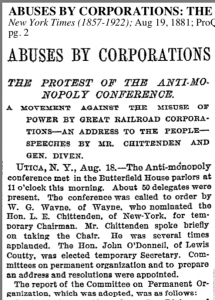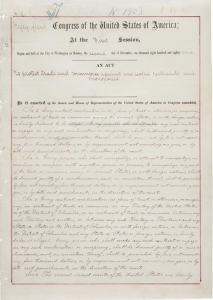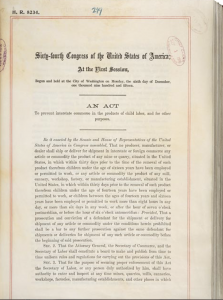Social Backlash

This source is a political cartoon displaying affects of Robber Barrons on the distribution of the nations’ wealth. It was illustrated by Joseph Keppler and displayed in Puck Magazine on January 23, 1889. This image, entitled Bosses of the Senate depicts Robber Barrons as gigantic money bags in comparison to the rest of the senate who is much, much smaller than them. This is supposed to represent that the robber Barron’s money makes them much more powerful than everyone else in the senate. The underlying message this cartoon gives is that money is equivalent to power during the Gilded Age. Keppler is depicting these Barrons in a negative image, which shows that he is not in support of them holding all of the power. The purpose of him illustrating this cartoon is to inform the unknowing Americans that their senate is being run by a select few insanely rich business owners. This image was found on senate.gov.

This political cartoon depicts the Standard Oil company within their process of vertical integration of their competition. An octopus is pictured with a Standard Oil logo and its’ tentacles are grasping and suffocating images that depict all of their competitors. This cartoon displays the popular opinion of monopolies ruining many things, for the octopus exemplifies greed and evilness. The purpose of this cartoon is to share Keppler’s opinion that monopolies, like Standard Oil, exhibit greed and too much wealth. The source was originally published in Puck Magazine on September 7, 1907, by Joseph Keppler.

In 1881, the New York Times published an article speaking of anti-monopoly protests that had taken place in Utica, NY. It wrote about the anti-monopoly conference meeting and what came out of it. Fifty delegates were in attendance and multiple gave speeches. This article was written for an audience of people who were not in attendance at this conference and were interested in learning what happened, with a purpose of informing the general public of the happenings in the conference. At the closing of the article, the principles and objectives of the anti-monopoly conference are stated. They state that they swear to defend the rights of as many as they can, so privilege can be more dispersed amongst the nations’ people. Monopolies were highly related to the growth of large businesses over time, yet as time progressed, many people became extremely against them. The growth of big business was beneficial for some people, but for many they were hurt by the damaging effects of monopolies. This source was found in the Wall Street Journal through proquest.
Governmental Backlash – Legislation

The Interstate Commerce Act created the Interstate Commerce Commission on February 4, 1887. This made railroads the first industry subject to federal regulation. Within this act, regulations are created on how railroads will actually do business. This act was created in response to public outcry for railroad regulation. This shows that while the Gilded Age was met with loads of corruption, the government began listen to its’ people and what they wanted. Yet, since this was the governments’ first attempt at monopolistic regulation, it only allowed companies to be sued in court and was unable to accomplish many of its’ goals. This image of the original act was found on Ourdocuments.gov.

The Sherman Anti-Trust Act was passed in 1890 by Congress. This banned all practices that restricted free trade. It was the first congressional measure implemented to reduce the amount of Trusts in the nation. This act was based upon the power of congress to regulate interstate commerce. The purpose of this legislation was to begin to move the world away from monopolies and their controlling tendencies. This relates to this exhibitions, for it is the first and primary method of the government deciding to take control of the mess monopolies had made. Although the act was demolished five years after its passing, it had lasting social affects on the nation, for they were convinced that their government was attempting to fix this. This image of the original proclamation was found from Ourdocuments.gov.
The Clayton Anti-Trust Act was passed on October 8, 1914 in order to exempt labor unions from antitrust laws. The act stated that it would bridge the gap between monopolies and other businesses and “maintain market competition”. This act was passed as another attempt to reduce the power monopolies, about thirty years after the first pieces of legislation were passed.

The Keating-Owen Act was passed in 1916 in an attempt to outlaw child labor in interstate commerce manufacturing. This was passed because of the 1900 census report that there were two million children working in factories. The government received backlash from social workers condemning them for allowing the nations’ children to be put in such harmful situations. Similar tactics that were used to regulate interstate commerce were used here to regulate child labor. Child labor had become an extreme problem in the United States, with many children perishing in the extremely harsh conditions of factories. This act is connected to this exhibit because so many children worked in factories because of the economic inequalities created by the rise of monopolies. The original publication of this act was retrieved from the national archives by Ourdocuments.gov.
